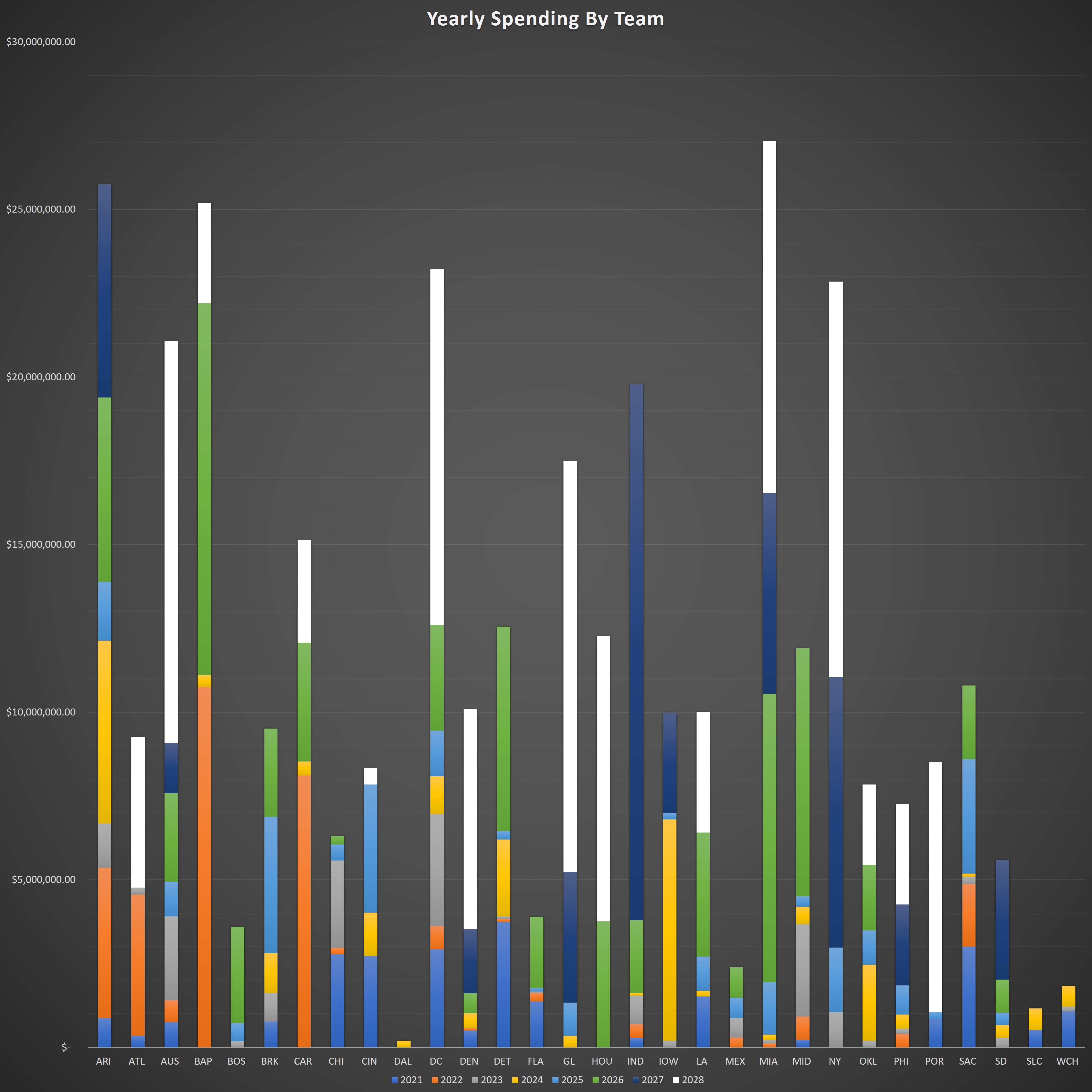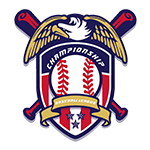Looking Back on Amateur Free Agency
International Amateurs have gotten a larger share of the market since the beginning of the CBA. Take this year’s signing period for example – the first ever $10 million bonus was handed out, BL teams began to splurge on the young, untested talents, and teams are beginning to open their wallets to improving the future at a higher rate and higher pace than ever before.
 As time has gone on, the amount of money poured into the amateurs has increased. It’s worth noting that, in the first signing period in 2021, teams had all the initial cash available, so some teams decided to splurge. Other teams waited and saved up their cash, as the next four years never broke above $33.5 million spent for the entire bunch of players.
As time has gone on, the amount of money poured into the amateurs has increased. It’s worth noting that, in the first signing period in 2021, teams had all the initial cash available, so some teams decided to splurge. Other teams waited and saved up their cash, as the next four years never broke above $33.5 million spent for the entire bunch of players.
2026 hit, and with it came the massive increase of contracts handed out. Teams now were getting massive budget increases which allowed them to allocate more money towards the amateur players. However, we had never seen a signing period in which the contracts handed out topped $100 million dollars.
Normally the teams that spent the most money in a signing period were PL teams, as they had the higher budgets. A BL team that wished to get those players were often forced to look at the lottery ticket players – the ones who, if everything worked out, would develop, but most of the time meant they were a waste of money. In 2028, the teams that led the charge were BL teams, who had saved up their cash – the top three money spenders were all BL teams (Great Lakes, Austin, New York), followed up by two perennial big spenders in Miami and DC, then Houston and Portland. Five of the top seven teams were in the BL, which shows just how much the philosophy has changed at the top – no more are the teams which appear to be headed to demotion at the beginning of the year (e.g. Great Lakes in 2024, Chicago in 2026) which meant that you had to not be in the bottom two teams. Now, in the PL, you’ve got nine teams who can all find themselves in the fourth spot (let’s be real, Cincy isn’t going anywhere) and all find themselves in the tenth spot. PL teams are more focused on spending to win now or to stay in the PL, whereas you’ve got the BL teams who are buying into the future.
 The teams that spend the most money usually are the teams that find themselves in the PL – as Miami, Bay Area, DC, and Indianapolis can attest to. You’ve also got four teams (New York, Austin, Carolina, Great Lakes) who find themselves in the BL at the moment. On the opposite end of the spectrum, you’ve got Dallas and Florida in the PL who have spend less than $4 million on amateurs (or, in the case of Dallas, $200,000. There’s a lot of scouting discoveries, trades, and picks in that system). However, not all money is spent alike…
The teams that spend the most money usually are the teams that find themselves in the PL – as Miami, Bay Area, DC, and Indianapolis can attest to. You’ve also got four teams (New York, Austin, Carolina, Great Lakes) who find themselves in the BL at the moment. On the opposite end of the spectrum, you’ve got Dallas and Florida in the PL who have spend less than $4 million on amateurs (or, in the case of Dallas, $200,000. There’s a lot of scouting discoveries, trades, and picks in that system). However, not all money is spent alike…
 As you can easily see, some teams find themselves signing more amateurs than others. Take DC, for example (I know that’s who you’re focusing on, because really – they’ve signed twice as many guys as the second place team). If you look back above, DC has spent the fourth most on amateurs, but have also signed the most by a wide margin.
As you can easily see, some teams find themselves signing more amateurs than others. Take DC, for example (I know that’s who you’re focusing on, because really – they’ve signed twice as many guys as the second place team). If you look back above, DC has spent the fourth most on amateurs, but have also signed the most by a wide margin.
It’s worth noting that the four PL teams that are on the upper tier in the total spent chart all started in the BL at one point, sans Arizona. So, at one time or another, seven of the eight teams were (or are) in the BL. If there is a general strategy, it’s that when you’re in the BL, spend on amateurs. But how has that really worked out?
Let’s take a look at Miami. Miami has the number one ranked system in the league, though their top two prospects – John Chrisman and Mario Valdez – weren’t amateur signers. Instead, only two of the top five in that system were signed as part of the amateur free agency process. Both Mario Diaz and Juan Rojas set the bar for modern day amateur signings, with both setting records at the time. In the case of Diaz, a few years back, but Rojas’ record occurred just a month ago. Now, taking a look at DC, their big amateur signings have yet to pan out. First baseman Jose Lopez just set the highest paid player in their system at a $6.5 million bonus, but he’s still young for us to pass judgement on yet. Alejandro Alonzo was the second highest paid position player in 2021, but he’s stuck at the reserves level. Massimo Battisti signed for the second highest amount in 2023 at $2.35 million, but he’ll be at a number five starter or long man in the future. Instead, their best amateur signing lies with Jose Maldonado, the number four ranked starting pitching prospect in the league. Signed at just $300,000, Maldonado was that one in 50 that worked out better than expected for DC. But that still meant a lot of dumped money into players that never worked out.
 However, that average contract DC handed out was never too high. They spent, on average just over $475,000 on every players, which includes the $10.6 million dropped this year. Take out that dump and the average comes in at $277,000 per player. Miami, on the other hand spends an average of $3.861 million per player. You could say that it’s panned out for them (at least in the present) with Juan Rojas, Jonathan Anaya, and Mario Diaz looking like a top infield to rival Dallas in the future. Great Lakes, Houston, Portland, and New York all have inflated averages due to a sudden buy in on the most expensive year yet of amateur free agents. However, the two teams left that have spent over $1.5 million per player are Bay Area and Carolina. The Pandas’ big signings are Miguel Montano, Hector Corrales, and Bobby Torres. Among those three, Montano looks like the real deal, Corrales looks like a SL/PL kind of pitcher, and Torres has fallen off a cliff. It’s a case of cold, warm, and hot, but you never quite know what you’re getting.
However, that average contract DC handed out was never too high. They spent, on average just over $475,000 on every players, which includes the $10.6 million dropped this year. Take out that dump and the average comes in at $277,000 per player. Miami, on the other hand spends an average of $3.861 million per player. You could say that it’s panned out for them (at least in the present) with Juan Rojas, Jonathan Anaya, and Mario Diaz looking like a top infield to rival Dallas in the future. Great Lakes, Houston, Portland, and New York all have inflated averages due to a sudden buy in on the most expensive year yet of amateur free agents. However, the two teams left that have spent over $1.5 million per player are Bay Area and Carolina. The Pandas’ big signings are Miguel Montano, Hector Corrales, and Bobby Torres. Among those three, Montano looks like the real deal, Corrales looks like a SL/PL kind of pitcher, and Torres has fallen off a cliff. It’s a case of cold, warm, and hot, but you never quite know what you’re getting.
The cautionary tale here is Carolina. In 2022, Carolina decided to splurge and gain the services of three big name players.
The first was Oscar Herrera. Signed for a $2.36 million contract, Herrera was a first baseman who the Carolina scouting department was (apparently) big on. We’ll never know exactly what the front office thought of Herrera, and whether he was signed because he was “good” or if they had money to burn. Herrera is currently playing for the DEV-B Lexington Barons in the Philadelphia system.
The second was Elias Mera. He was signed for an estimated $4.25 million as a starter. We don’t quite know the exact price because there is little around today that pertains to him. Nobody knows if he got hurt and retired, if he wasn’t good, or if he just plain quit – all we know is that he took a large chunk of money and ran. If you’re interested in what $4.25 million would be like today, it equates to about a $11 million bonus.
The third is Alberto Cruz. A fragile pitcher signed at a record $5.75 million bonus, Cruz developed fast enough to break into the Carolina rotation at the age of 20, where he currently sits with a career ERA+ of 127 after going 2-4 with four saves and a 3.11 ERA over 11 starts and 19 games this season. OSA has him ranked as the fourth best starter in the BL right now.
 The consensus is: Spend money on amateurs. But, at the same time, be very, very careful who you give money to. A lot of these guys will be boom or bust type players, but only teams that develop these guys properly will get their money back.
The consensus is: Spend money on amateurs. But, at the same time, be very, very careful who you give money to. A lot of these guys will be boom or bust type players, but only teams that develop these guys properly will get their money back.

